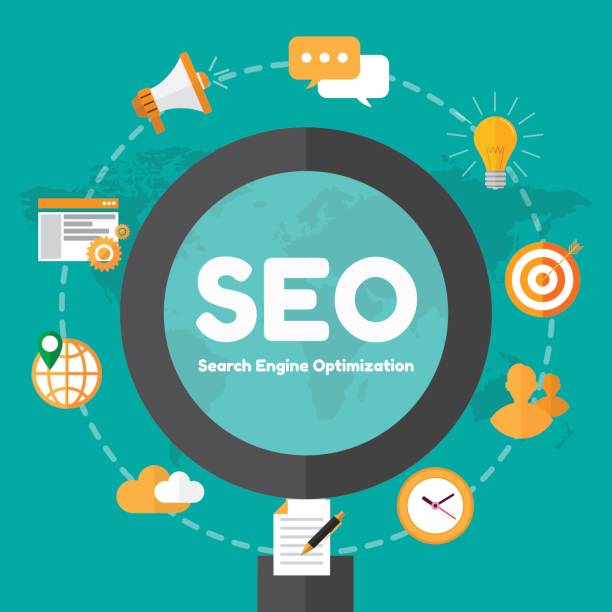Introduction to SEO and Its Importance in the Digital World

In today’s highly competitive world, having an online presence merely by owning a website is not enough.
To be seen and attract an audience, you need effective strategies that make your website stand out in search engine results.
This is where #SEO, or #Search_Engine_Optimization, plays its vital role.
SEO is a process through which your website is optimized to rank higher in search engines like Google, Bing, and Yahoo.
This optimization includes a set of techniques and methods that help search engines better understand your site’s content and display it to users relevant to their searches.
The main goal of SEO is to increase organic (unpaid) traffic to your website, which usually has a higher quality because users themselves are looking for your information or products.
The importance of SEO is evident not only in attracting traffic but also in building credibility and trust for your brand.
When your website ranks high in search results, it means that search engines recognize it as a reliable and authoritative source.
For success in the digital realm, a deep understanding of SEO is an educational and essential matter.
Without SEO, even the best content and products might get lost among the vast amount of information available on the web.
Therefore, investing in SEO is not just an expense, but a long-term investment for the growth and sustainability of your business.
Correct implementation of SEO principles can make a significant difference in your online visibility and success.
In fact, SEO is not just a technique, but a strategic mindset for a powerful presence in the web space.
Don’t forget that your competitors are also striving to improve their SEO, and falling behind in this competition means losing market share.
SEO knowledge helps you stay one step ahead and benefit from attracting new customers.
This comprehensive SEO process includes various aspects that we will discuss in detail below.
Did you know that 85% of customers check your company’s website before any interaction?
With Rasaweb, build a corporate website worthy of your credibility.
✅ Increase customer credibility and trust
✅ Attract high-quality leads
⚡ Get free website design consultation
Identifying and Differentiating Types of SEO: On-Page, Off-Page, and Technical

To fully understand SEO and implement it effectively, it is essential to become familiar with its different types.
In general, SEO is divided into three main categories: On-Page SEO, Off-Page SEO, and Technical SEO.
Each of these sections covers different aspects of optimization, and to achieve optimal results in Google rankings, they must be addressed simultaneously and in coordination.
On-Page SEO includes all actions performed within your website to improve its ranking in search results.
These actions include optimizing content, keywords, titles, meta descriptions, URL structure, image optimization, internal links, and user experience (UX).
Engaging and high-quality content that meets user needs is one of the most important factors in On-Page SEO.
By optimizing these elements, you signal to search engines that your website is relevant and valuable.
On the other hand, Off-Page SEO refers to activities performed outside your website, aiming to increase its Domain Authority.
The most crucial part of Off-Page SEO is building quality backlinks from reputable websites.
Backlinks show search engines that your website is trusted by others.
Social media activity, influencer marketing, and online brand building are also part of Off-Page SEO strategies.
The third section, Technical SEO, focuses on optimizing the technical aspects of your website for search engine crawlers.
This includes site loading speed, #crawlability and #indexability, mobile-friendliness, #SSL (HTTPS) usage, XML sitemap, and robots.txt file.
Without a strong technical foundation, even the best content and backlinks cannot fully realize their potential in SEO.
Therefore, a website must be technically sound so that search engines can easily #crawl and #index its content.
Understanding the differences and interconnections among these three types of SEO is essential for creating a comprehensive SEO strategy.
Neglecting any of these sections can lead to a decrease in overall SEO performance and make it difficult to achieve high rankings in search results.
In summary, for successful SEO, all three aspects must be carefully and continuously addressed and improved.
This explanatory approach to SEO fundamentals is the first step on the path to becoming an SEO expert.
Keyword Research: The Backbone of SEO Strategy

Keyword research, as the #backbone of any successful #SEO strategy, is a specialized and vital process.
This process involves finding the words and phrases your target users type into search engines to find products, services, or information related to your business.
By accurately identifying these keywords, you can optimize your content to meet user needs and, as a result, attract relevant and high-quality traffic to your website.
The first step in keyword research is #brainstorming and gathering ideas.
Think about what words and phrases your audience searches for. Then, you can use keyword research tools like Google Keyword Planner, Ahrefs Keywords Explorer, Semrush Keyword Magic Tool, or even Google’s autocomplete suggestions to expand your list.
These tools help you evaluate search volume, competition, and the relevance of keywords.
Paying attention to Intent (user intent) is crucial when selecting keywords.
Is the user looking for information (informational keywords), intending to buy (commercial/transactional keywords), or searching for a specific website (navigational keywords)? Choosing keywords that align with user intent increases your chances of attracting quality traffic and higher conversion rates.
Also, focusing on #Long_Tail keywords, which are usually longer and more specific, can be very beneficial.
These keywords generally have lower search volume but come with higher conversion rates because users at this stage of their search know exactly what they want.
Keyword research is not a one-time process; it requires continuous review and updates to keep pace with changes in user search behavior and market trends.
With this approach, you can ensure that your SEO strategy remains dynamic and effective.
The table below can serve as a general #guideline for keyword types and their application in SEO.
This deep understanding of keywords is the foundation of success in any SEO campaign and helps you create content that is not only optimized for search engines but also truly valuable to users.
Without proper keyword research, your SEO efforts might go to waste.
Therefore, take this step seriously and dedicate enough time to it to achieve the best SEO results.
| Keyword Type | User Intent | Example | Suitable for (Content Type in SEO) |
|---|---|---|---|
| Informational | Gaining information, solving a problem | “How to do SEO?”, “Benefits of meditation” | Blog articles, guides, FAQs |
| Navigational | Searching for a specific website or brand | “SEO Academy website”, “Digikala login” | Home pages, contact pages, about us pages |
| Commercial | Comparing products, pre-purchase research | “Best laptop for programming”, “LG TV price” | Product/service pages, comparison pages |
| Transactional | Intending to buy or perform a specific action | “Buy SEO book”, “Download website design software” | Product pages, pricing pages, landing pages |
Optimizing Content for Search Engines and Users

After keyword research, the next step in SEO is content creation and optimization.
Content is #king of SEO, but only a king that is valuable to search engines and equally to users.
Optimizing content for SEO does not mean stuffing the text with keywords, but rather producing content that is comprehensive, accurate, engaging, and optimized for crawlability by search engines.
Your content should become #engaging_content, meaning it should be able to answer user questions and make them think.
Well-SEO-optimized content should have attractive titles (Title Tags) and meta descriptions (Meta Descriptions) that both include primary keywords and entice users to click.
Content structure is also very important; using Heading tags (H1, H2, H3…) helps search engines understand the structure and main topic of your content.
Additionally, these tags improve readability for users.
Content SEO goes beyond words; optimizing images (using descriptive Alt Text), videos, and other multimedia elements is also part of it.
Content quality in SEO is a very important ranking factor.
Your content should be original, comprehensive, and authoritative.
Avoiding duplicate content and ensuring the accuracy of the information provided is essential for building trust with both users and search engines.
Content length can also play a role; usually, longer and more in-depth content has a better chance of ranking for competitive keywords, provided that every word is valuable and does not lead to verbosity.
Adding #internal_links to relevant pages on your website not only helps improve user navigation but also contributes to the distribution of “SEO value” throughout your site (known as #link_juice).
Content that engages users creates a longer dwell time on your site and reduces the bounce rate, all of which are positive signals for SEO.
Ultimately, content optimization is a continuous process that requires regular review and updates to keep pace with the latest SEO trends and changing user needs.
Therefore, always keep your content updated and review it from both the user’s and search engine’s perspective to get the best SEO results.
Are you tired of your e-commerce website not generating as much revenue as it could? Rasaweb, specializing in professional e-commerce website design, solves this problem forever!
✅ Increase sales rate and revenue
✅ High loading speed and unparalleled user experience
⚡ Get free e-commerce website design consultation!
Technical SEO and Its Vital Role in Improving Site Ranking

Technical SEO is the foundation of any successful SEO strategy and involves optimizing the technical aspects of your website.
This part of SEO is often overlooked, but it plays a vital role in helping search engines crawl, index, and effectively rank your website.
Without a strong technical foundation, even the best content and strongest off-page SEO strategies cannot reach their full potential in SEO.
One of the most important aspects of technical SEO is site loading speed.
Users and search engines care about website speed.
Slow websites can lead to high bounce rates and lower rankings.
Compressing images, using caching, optimizing code, and choosing appropriate hosting are among the actions that help improve site speed.
Crawlability and Indexability are also key components of technical SEO.
Ensuring that your robots.txt file and XML sitemap are correctly configured helps search engines find and add important pages of your site to their index.
Google Webmaster Tools (Google Search Console) play a vital analytical role in identifying crawling and indexability issues.
Mobile-Friendliness is another important factor in technical SEO, especially given the increased use of mobile for searching.
Your website should be responsive and provide a good user experience across different devices.
Using HTTPS instead of HTTP not only increases your website’s security but is also a positive ranking factor for SEO.
URL structure, resolving 404 errors, correct redirects, and using structured data (Schema Markup) to help search engines better understand your content, are all part of technical SEO.
A strong #technical_SEO shows search engines that your website has a #stable and #reliable_platform.
This not only helps improve rankings but also significantly enhances user experience.
Therefore, regular review of the technical aspects of your website and resolving any issues are essential for maintaining and improving your SEO performance.
Technical SEO, in fact, ensures that your efforts in content SEO and off-page SEO are not wasted.
Backlinks and Domain Authority in Off-Page SEO

Backlinks (Backlinks) are one of the most powerful ranking factors in off-page SEO and act as a “vote of confidence” from other websites to yours.
The greater the number and quality of inbound backlinks to your website, the more your Domain Authority increases in the eyes of search engines, which significantly helps improve SEO rankings.
Domain Authority indicates the power and trustworthiness of a website.
But the important point is that not all backlinks are created equal.
Backlinks received from high-quality websites, relevant to your industry, and with high authority, are much more valuable than links from spammy or irrelevant websites.
The backlink building strategy should focus on quality, relevance, and diversity, not just quantity.
Acquiring backlinks can be done through various methods, including guest blogging (writing articles for other websites and receiving a link), creating shareable and engaging content (which naturally attracts links), broken link building (finding broken links on other websites and suggesting replacing them with your content), and building relationships with influencers and industry experts.
Any activity involving #artificial_link_building and spam should be avoided, as these actions not only do not help your SEO but can also lead to penalties from search engines.
Off-page SEO is not limited to backlinks; social media activities, Brand Mentions, and participation in relevant online forums also indirectly affect your online credibility and, consequently, SEO.
Regular monitoring and auditing of your backlink profile are vital to identify toxic links and prevent their negative impact on your website’s SEO.
Tools like Ahrefs Backlink Checker and Semrush Backlink Analytics can be helpful in this regard.
For success in off-page SEO, it is important to have an informed and smart approach, meaning you should always be aware of the latest changes in Google’s algorithms and adjust your strategies accordingly.
Ultimately, backlinks and domain authority are two fundamental pillars for building strength in SEO that cannot be ignored and require long-term effort and patience to be effective.
Measuring and Analyzing SEO Results for Continuous Improvement

After implementing SEO strategies, the next crucial step is measuring and analyzing the results.
Without this step, you cannot evaluate the effectiveness of your efforts and identify strengths and weaknesses.
This continuous analysis allows you to optimize your SEO strategy and implement necessary improvements.
Numerous analytical tools are available to help you on this path.
Google Search Console (GSC) is a free and essential tool from Google that provides detailed information about your website’s performance in search results.
This information includes keywords with which users found you, crawling and indexability issues, and reports on backlinks and Page Experience.
GSC is an invaluable educational resource for any SEO professional.
Google Analytics (GA) is another Google tool that collects data on user behavior on your website.
Through GA, you can view information such as the number of visitors, visited pages, time spent on site, bounce rate, and conversion paths.
Combining GSC and GA data provides a comprehensive view of your SEO performance and user interaction with your website.
Key Performance Indicators (KPIs) in SEO include: organic traffic (increase in visitors through natural search), keyword ranking (your pages’ position for target keywords), conversion rate (number of users performing a desired action like purchase or sign-up), and domain authority.
Regular monitoring of these metrics helps you identify positive or negative trends and react to them quickly.
For example, if a specific keyword’s ranking has dropped, you can review and update the relevant content.
Also, analyzing competitors and examining their SEO strategies can provide valuable insights for improving your own strategy.
SEO is not a static process and always requires continuous improvement.
By carefully analyzing data and making necessary changes, you can continuously enhance your website’s SEO performance and ensure a strong presence in search results.
This analytical and data-driven approach is the key to sustainable success in SEO.
The table below shows some of the Key Performance Indicators (KPIs) in SEO.
| Key Performance Indicator (KPI) | Description | Monitoring Tools |
|---|---|---|
| Organic Traffic | Number of visitors coming from search engines (unpaid) | Google Analytics, Google Search Console |
| Keyword Ranking | Your website’s position for specific keywords in search results | Google Search Console, Ahrefs, Semrush |
| Click-Through Rate (CTR) | Percentage of users who click on your website after seeing it in search results | Google Search Console |
| Dwell Time | The amount of time users spend on your page | Google Analytics |
| Bounce Rate | Percentage of users who leave your website after visiting one page without viewing any other page | Google Analytics |
| Conversion Rate | Percentage of visitors who complete a desired action (e.g., purchase or sign-up) | Google Analytics |
Local SEO and Its Importance for Physical Businesses

Alongside general organic SEO, Local SEO is a distinct and vital segment, especially for businesses with a physical location or local audience.
Local SEO focuses on optimizing your online presence to appear in local search results, such as when someone searches for “restaurant near me” or “car repair shop in [city name]”.
This type of SEO helps your business be discovered by potential customers near your physical location.
The most important tool for local SEO is Google My Business (GMB).
Registering and optimizing your GMB profile is the first and most crucial step.
Ensuring the accuracy of your business information (Name, Address, Phone number – known as NAP), business hours, quality images, and receiving positive customer reviews are very effective in local ranking.
Customer reviews not only increase your credibility but are also an important ranking factor in local SEO.
Responding to these reviews, whether positive or negative, is also very important.
In addition to GMB, creating #Local_Citations in other online directories such as Yelp, Bing Places, and relevant industry directories helps search engines confirm the accuracy of your business information.
These citations must perfectly match your GMB information to avoid confusing search engines.
Optimizing your website content with local keywords (e.g., “best [service] in [city]”) and creating local pages for each branch or service area can also help improve local SEO.
Local SEO can have a direct impact on sales and physical store visits.
Statistics show that many local searches lead to store visits or phone calls.
Therefore, businesses looking to attract local customers cannot ignore local SEO.
This is a practical guide for any small and medium-sized business to be seen and grow in today’s competitive market.
By investing appropriately in local SEO, you can ensure that your business is accessible when customers need you and ranks at the top of local search results.
SEO local truly empowers small businesses to compete with industry giants and succeed.
Are you tired of your e-commerce website not generating as much revenue as it could? Rasaweb, specializing in professional e-commerce website design, solves this problem forever!
✅ Increase sales rate and revenue
✅ High loading speed and unparalleled user experience
⚡ Get free e-commerce website design consultation!
Future Trends in SEO and Preparing for Them

The world of SEO is constantly changing and evolving.
What is effective today might be obsolete tomorrow; therefore, SEO specialists must continuously keep themselves updated with the latest SEO trends.
Understanding future trends and preparing for them is key to maintaining a competitive advantage in the digital space.
One of the most important future trends in SEO is the growing role of Artificial Intelligence (AI) in search engines.
Algorithms like Google BERT and MUM indicate that Google is increasingly understanding natural language and user intent.
This means your content should focus more on answering complex questions and providing comprehensive and accurate information, rather than solely on specific keywords.
Voice search is also on the rise.
With the widespread use of voice assistants like Siri, Alexa, and Google Assistant, optimizing for Voice Search SEO becomes more important.
Voice searches are typically longer, more conversational, and question-based.
Therefore, using natural language in content and directly answering potential user questions will be vital in future SEO.
Additionally, User Experience (UX) has become a primary ranking factor.
Google, by introducing Core Web Vitals, has emphasized the importance of page loading speed, interactivity, and visual stability.
Websites with poor user experience may face issues in SEO.
E-E-A-T (Experience, Expertise, Authoritativeness, Trustworthiness) has also gained increasing importance, especially in sensitive content areas like medical or financial.
Google seeks sources that demonstrate knowledge, expertise, authority, and trustworthiness.
This means you must ensure your content is written by experts and is reliable.
Video SEO is also growing due to the popularity of platforms like YouTube and TikTok.
Optimizing videos for search, by using keywords in titles and descriptions, subtitles, and tags, can bring significant traffic to you.
Ultimately, focusing on #meaningful and #high-quality_content, instead of short-term tricks, will gain more importance in the future of SEO.
SEO is moving towards providing the best experience and most relevant information to the user.
Awareness of these trends and investing in them will help you prepare your SEO strategy for years to come and benefit from it in the competitive SEO landscape.
This is an analytical insight that should be incorporated into your SEO plan.
SEO: A Continuous Process Requiring Constant Updates

Contrary to popular belief, SEO is not a one-time project that ends once completed.
Instead, SEO is a continuous, dynamic process requiring constant updates.
Search engines constantly change their algorithms, user behavior evolves, and competitors are always striving to improve their rankings.
Therefore, to maintain and improve your position in search results, you must continuously monitor, analyze, and optimize your SEO strategy.
Regular performance monitoring of your website in Google Search Console and Google Analytics is essential to identify any drop in traffic or rankings.
These tools can indicate new technical issues, changes in keyword trends, or even potential penalties that require immediate action.
Content updating is also a crucial part of ongoing SEO.
Outdated content may contain obsolete information or may not be able to compete with newer content.
By rewriting, adding new information, updating statistics, and incorporating new relevant keywords, you can extend the life of your content and keep it fresh for SEO.
This shows search engines that your website is active and providing quality content.
Technical SEO also requires regular reviews and updates due to changes in web technology and browser standards.
Ensuring proper loading speed, mobile compatibility, and structural integrity of the website, should always be a priority.
Off-page SEO activities, such as backlink building, must also continue to continuously strengthen your domain authority.
Searching for new opportunities to acquire quality backlinks and maintaining relationships with authoritative websites are ongoing tasks of a sustainable SEO strategy.
Competition in the online space never stops.
Your competitors are also trying to improve their SEO, and if you stop, they will overtake you.
Therefore, this #dynamic_competition makes SEO an enjoyable and challenging process.
This explanatory approach to the importance of continuity in SEO helps you view the SEO process as a long-term investment for your business’s success, rather than just focusing on immediate results.
By understanding this, you can allocate the necessary resources for a sustainable SEO strategy and benefit from it.
Frequently Asked Questions
| Question | Answer |
|---|---|
| What is SEO? | SEO, or Search Engine Optimization, is the process of increasing the quality and quantity of website traffic by improving the site’s ranking in natural (organic) search results of search engines like Google. |
| What are the main types of SEO? | SEO is divided into three main categories: On-Page SEO, Off-Page SEO, and Technical SEO. |
| What does On-Page SEO include? | On-Page SEO involves optimizing elements within the website, such as keywords, page title (Title Tag), meta description (Meta Description), content, URL structure, images, and internal links. |
| What is Off-Page SEO? | Off-Page SEO refers to activities performed outside the website that help improve its ranking, such as backlink building, social media marketing, and brand mentions. |
| What is Technical SEO? | Technical SEO focuses on optimizing the technical aspects of the website to help search engines crawl and index it better. This includes site speed, mobile-friendliness, site structure, sitemaps, and the Robots.txt file. |
| What role do Keywords play in SEO? | Keywords are phrases that users enter into search engines. The correct and targeted use of relevant keywords in content and site elements helps search engines understand your page’s topic and display it for relevant searches. |
| What is a Backlink and why is it important? | A backlink, or inbound link, is a link from one website to another. Backlinks act as a “vote of confidence” from other sites for search engines and play a crucial role in the credibility and ranking improvement of a site, especially if they come from authoritative sites. |
| What impact does quality content have on SEO? | Quality, relevant, comprehensive, and unique content not only attracts and retains users but also shows search engines that your page is valuable. This helps improve ranking, reduce bounce rate, and increase user dwell time on the site. |
| Why is site loading speed important for SEO? | Site loading speed is an important ranking factor for Google. Faster sites provide a better user experience, have lower bounce rates, and are preferred by search engines. |
| Is SEO a one-time process? | No, SEO is a continuous and long-term process. Search engine algorithms are constantly changing, competition is increasing, and site content also needs updating. Therefore, SEO requires continuous monitoring, analysis, and optimization. |
And other services of Rasaweb Advertising Agency in the field of advertising
Smart Digital Advertising: A new service to increase user engagement through attractive UI design.
Smart Marketing Automation: A professional solution to improve SEO ranking with a focus on attractive UI design.
Smart Data Analysis: A combination of creativity and technology to attract customers through custom programming.
Smart UI/UX: A creative platform to improve click-through rate increase with attractive UI design.
Smart SEO: Designed for businesses looking to increase click-through rate through marketing automation.
And over a hundred other services in the field of internet advertising, advertising consulting, and organizational solutions
Internet Advertising | Advertising Strategy | Advertorial
Sources
Complete SEO Guide on Rastin
Website Optimization Tutorial on Sib
SEO Checklist for Online Success
Modern SEO Strategies on SemSEO
? With Rasaweb Afarin, take your business to digital heights and establish a powerful presence in the online world, tailored to today’s needs, through our specialized services including corporate website design. To learn more about our comprehensive digital marketing solutions, visit Rasaweb Afarin’s website.
📍 Tehran, Mirdamad Street, next to Central Bank, Southern Kazeroun Alley, Ramin Alley, No. 6




